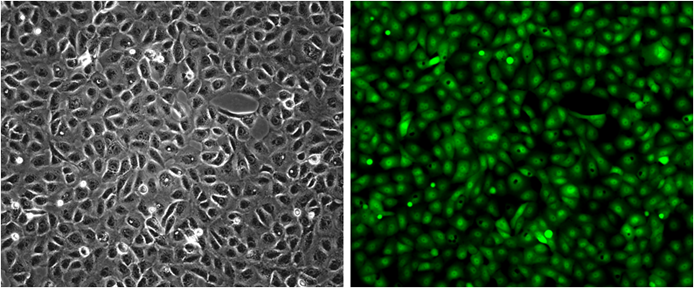Gfp Cell Line

A GFP cell line is a type of cell culture that has been engineered to express the green fluorescent protein (GFP) gene. GFP is a protein that glows green when exposed to ultraviolet light, making it a useful tool for tracking and visualizing cells.
GFP cell lines are created by transfecting cells with a DNA construct containing the GFP gene. This DNA construct can be integrated into the genome of the cells, or it can exist as an extrachromosomal plasmid. Once the cells have been transfected with the GFP gene, they will begin to express GFP protein.
GFP cell lines are used in a variety of research applications, including:
- Tracking cell migration and movement: GFP cell lines can be used to track the movement of cells in vivo and in vitro. This is useful for studying cell development, differentiation, and cancer metastasis.
- Visualizing cell interactions: GFP cell lines can be used to visualize the interactions between cells and other cells, or between cells and their environment. This is useful for studying cell signaling, cell adhesion, and host-pathogen interactions.
- Studying protein expression and localization: GFP cell lines can be used to study the expression and localization of proteins within cells. This is useful for understanding the function and regulation of proteins.
GFP cell lines are a versatile tool for studying cell biology and physiology. They are used in a wide range of research applications, and they are becoming increasingly popular as a tool for drug discovery and development.
GFP cell lines:
- HEK293-GFP: This cell line is derived from human embryonic kidney cells. It is a commonly used cell line for expressing GFP and other recombinant proteins.
- HeLa-GFP: This cell line is derived from human cervical cancer cells. It is a commonly used cell line for studying cell biology and cancer biology.
- Jurkat-GFP: This cell line is derived from human T lymphocytes. It is a commonly used cell line for studying immunology and cancer biology.
GFP cell lines are a valuable tool for biomedical research. They are used to study a wide range of cellular processes and diseases.
- GFP cell lines are stable: Once a GFP cell line has been established, it can be maintained for long periods of time without losing its ability to express GFP protein. This makes them a valuable tool for long-term research studies.
- GFP cell lines are easy to manipulate: GFP cell lines can be easily manipulated by genetic engineering techniques. This allows researchers to create cell lines that express GFP protein specifically in certain cells or tissues, or to study the effects of specific mutations on GFP expression.
- GFP cell lines are non-toxic: GFP protein is non-toxic to cells. This makes GFP cell lines safe to use in research studies.
GFP cell lines are a versatile and powerful tool for studying cell biology and physiology. They are used in a wide range of research applications, including drug discovery and development.
How GFP cell lines are being used in research today:
- GFP cell lines are being used to study the development of cancer cells. Researchers are using GFP cell lines to track the movement and proliferation of cancer cells, and to identify new targets for cancer therapy.
- GFP cell lines are being used to study the immune response to infection. Researchers are using GFP cell lines to track the movement and activation of immune cells, and to identify new ways to boost the immune response to infection.
- GFP cell lines are being used to study the development of new drugs. Researchers are using GFP cell lines to screen for new drugs that can target specific cellular processes.
GFP cell lines are a valuable tool for biomedical research. They are helping us to better understand the cellular basis of disease and to develop new treatments for diseases.
